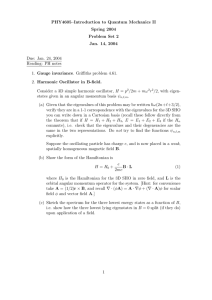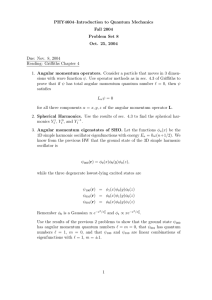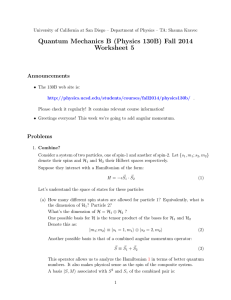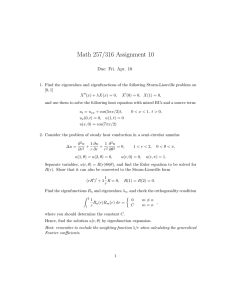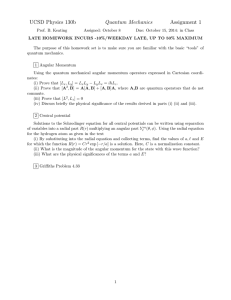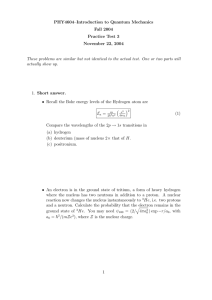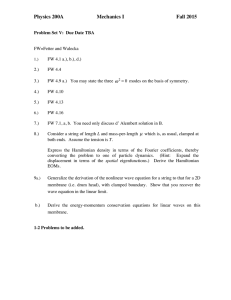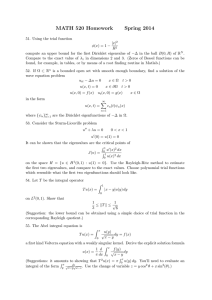1. Angular momentum, classical and quantum mechanical.
advertisement
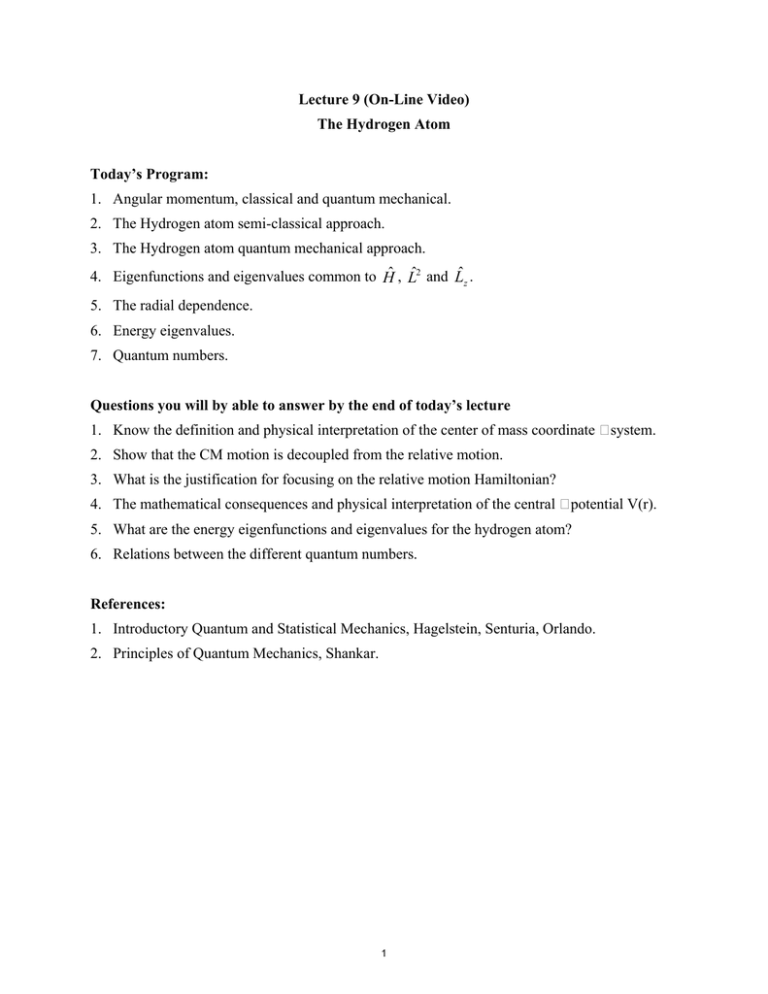
Lecture 9 (On-Line Video) The Hydrogen Atom Today’s Program: 1. Angular momentum, classical and quantum mechanical. 2. The Hydrogen atom semi-classical approach. 3. The Hydrogen atom quantum mechanical approach. 4. Eigenfunctions and eigenvalues common to Ĥ , L̂2 and L̂z . 5. The radial dependence. 6. Energy eigenvalues. 7. Quantum numbers. Questions you will by able to answer by the end of today’s lecture 1. Know the definition and physical interpretation of the center of mass coordinate �system. 2. Show that the CM motion is decoupled from the relative motion. 3. What is the justification for focusing on the relative motion Hamiltonian? 4. The mathematical consequences and physical interpretation of the central �potential V(r). 5. What are the energy eigenfunctions and eigenvalues for the hydrogen atom? 6. Relations between the different quantum numbers. References: 1. Introductory Quantum and Statistical Mechanics, Hagelstein, Senturia, Orlando. 2. Principles of Quantum Mechanics, Shankar. 1 The Hydrogen atom I The system Hydrogen atom consists of a proton of mass m p 1.7 10 27 kg and charge q 1.6 10 19 Coulomb and an electron of mass me 9.110 31 kg and charge q . Consequently they are bound by a Coulombic potential: V r e2 q2 1 4 0 r r Where: 0 8.851012 F / m is the permittivity of free space. II The Classical Hamiltonian p 2 e2 H r, p 2 r Where: me m p me is a reduced mass. me m p Semiclassical Bohr model that yielded correct energy (but produced generally incorrect results) relied on the conservation of energy, angular momentum and the balance of forces. e2 1 E v2 Energy 2 r v2 e 2 2 Balance of centripetal and Coulombic forces r r These are classical equations that assume an electron trajectory, which we already know is inconsistent with the experimental evidence. The additional assumption, which had no classical justification, was that the angular momentum could only assume certain values: vr n From these assumptions Bohr deduced the energy levels for electrons inside the Hydrogen atom and the radius of the Hydrogen atom: EI e 4 , E 13.6 eV I n2 2 2 2 rn n 2 a0 , a0 2 0.529 A Bohr radius e En This was an enormous step towards the understanding of experimentally observed spectra of Hydrogen atom since it yielded the correct values for the energy levels (1/n2 dependence). In addition Bohr model correctly predicted the experimentally measured ionization energy (the energy which must be supplied to the atom in order to remove an electron from the ground state). Also the Bohr radius also correctly described atomic dimensions. 2 III The Quantum mechanical Hamiltonian p̂22 p̂12 V̂ r̂2 r̂1 Ĥ r̂1, r̂2 , p̂1, p̂2 2m1 2m2 Let’s perform the following coordinate transform – break our system into a relative motion of electron and a nucleus the motion of the center of mass: ̂ ̂ ˆ m1r1 m2 r2 RCM m1 m2 ̂ ̂ ̂ r r1 r2 ˆ PCM pˆ1 p̂2 m2 p̂1 m1 p̂2 p̂ m1 m2 ˆ p̂ 2 P̂ 2 V̂ r̂ Ĥ CM Ĥ r Ĥ r̂, p̂, PCM CM 2M 2 m1m2 , M m1 m2 m1 m2 Since the Center of Mass Hamiltonian commutes with the relative motion Hamiltonian, it commutes with the whole system Hamiltonian, which means that energy of the center of mass is conserved and can be used to label states. Then the Hamiltonian above breaks into two independent problems – one for center of mass and another one for relative motion: Ĥ CM u ECM u Ĥ CM , Ĥ r 0 Ĥ r u Er u ˆ Hu ECM Er u The center of mass problem is pretty much identical to the particle in free space and consequently we will not focus on it. Instead let us consider the relative motion problem because it actually is a problem of electron motion around the nucleus (nucleus is several orders of magnitude heavier). 2 2 2 2 e 2 Ĥ r r̂, p̂ 2 2 2 2 x y z r Let’s change to the spherical coordinate system: x r sin cos y r sin sin z r cos 1 2 1 1 2 e 2 2 1 2 Ĥ r r̂, p̂ r 2 r r 2 r 2 2 tan sin 2 2 r 3 IV Finding the eigenfunctions and eigenvalues of the Hamiltonian. 1 2 1 1 2 e 2 2 1 2 Ĥ r r̂, p̂ r 2 r r 2 r 2 2 tan sin 2 2 r 2 1 2 e2 L̂2 Ĥ r r̂, p̂ r 2 r r 2 2r 2 r 2 1 1 2 2 L̂2 2 2 tan sin 2 Then we need to solve the following eigenvalue problem for the time-independent Hamiltonian: 2 1 2 e2 L̂2 r u r, , Eu r, , 2 2 r 2 r 2 r r Note that the angular momentum squared operator commutes with the Hamiltonian and recall that it also commutes with the z-component of the angular momentum; consequently we can simultaneously solve the following equations: L̂z u r, , mu r, , 2 L̂ u r, , 2l l 1 u r, , Ĥu r, , Eu r, , Since we already know the form of eigenfunctions for L̂2 and L̂z : Yl m , we can look for the generalized solution in the form: unlm r, , Rnl r Yl m , n – the number associated with the eigenvalues of the energy operator called the principal quantum number. l – the number associated with the eigenvalues of the orbital angular momentum magnitude operator is called the orbital angular momentum quantum number. �m – the number associated with the eigenvalues of the z component of the orbital angular momentum called the magnetic quantum number. Substituting the function above into the time-independent Schrodinger’s equation (Hamiltonian eigenvalue problem) we get: 2 1 2 2l l 1 e 2 r Rnl r Enl Rnl r 2 2 r 2 r 2 r r We can identify a kinetic energy term and an effective potential energy, which is related to the magnitude of the total angular momentum vector: 4 Veff r l l 1 2 2 r 2 e2 r Akin to the harmonic oscillator eigenfunctions and the spherical harmonics the solution of the radial equation is obtained by a power series expansion method. Then the complete eigenfunctions and eigenvalues of the Hamiltonian are: unlm r, , Rnl r Yl m , En EI n2 Rnl r e r na0 3 2 n l 1! r 2l1 2r , n l, n 0 Lnl1 n 2n n l ! na0 na0 l Where L2l1 nl1 is the generalized Laguerre polynomials. Substituting it into Mathematica, we can find the Bohr radius: a0 2 0.529 A e 2 3 2 Example of atomic orbitals – 1s: u100 r, , R10 r Y , 2 a0 e 0 0 r a0 1 4 Labeling of states – quantum numbers The eigenfunctions are completely specified, when the three quantum numbers n, l, m are specified. The rules for these numbers are: n 1, n 1, 2, 3... 0 l n, l 0,1, 2... n 1 l m l, m l, l 1,...0,1,...l 1, l 5 Conclusions: 1. The energy levels or the energy eigenvalues En of the hydrogen atom depend only�on n , which is called the principal quantum number. 2. Since the energy levels and radial decay rate depend only on the n number this�number is used to identify an electron shell. 3. For each energy En , there exist several values of l:�l=0,...,n–1. This means that there are more than one eigenfunction for each energy eigenvalue with different angular momenta these are called subshells. 4. To each value of l correspond (2l+1) values of m: m=-l,-l+1..., l–1,l. Each sub-shell contains (2l+1) eigenfunctions or states. ln1 2 5. The levels of En are n degenerate: 2l 1 n 2 l0 6. The eigenfunctions common to L̂z , L̂2 , Ĥ unlm r, , are completely defined by �specifying three numbers, which are called quantum numbers n, l, m. 7. The angular dependence of the eigenfunctions is determined by the spherical harmonics: Yl m , . Since the dependence goes away upon squaring, one can plot a projection of the eigenfunction onto the z-x or z-y plane. The plots are surfaces of revolution about the z-axis. 8. The asymptotic behavior of the radial function Rnl r near the origin: Rnl r ~ r l Only eigenfunctions un00 r, , belonging to s-subshells have a non zero probability of being near the origin. 9. The spectroscopic notation assigns a letter to each subshell: l0s l 1 p l2d l 3 f 6 Discussion Comparison of the energy level (energy eigenvalues) spacing in free particle, 1D box, 1D harmonic oscillator, hydrogen atom. n=3 n=2 n=1 Images by MIT OpenCourseWare. 7 MIT OpenCourseWare http://ocw.mit.edu 3.024 Electronic, Optical and Magnetic Properties of Materials Spring 2013 For information about citing these materials or our Terms of Use, visit: http://ocw.mit.edu/terms.
